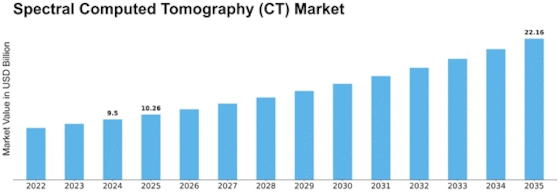-
Executive Summary
-
Market Introduction
-
Scope of the Study 12
-
Research Objective 12
-
List of Assumptions 12
-
Research Methodology
-
Research Process 14
-
Primary Research 15
-
Secondary Research 16
-
Market Size Estimation 17
-
Market Dynamics
-
Introduction 18
-
Drivers 19
- Increasing Expenditure on the Healthcare IT Sector 19
- Technological Advancements in the Diagnostics Sector 19
- Growing Prevalence of Diseases such as Cancer, Neurological Disorders, and Cardiac Diseases Across the Globe 20
- Drivers Analysis 20
-
Restraints 21
- High Cost of Spectral Computed Tomography 21
- Availability of Alternative Imaging Methods 21
- Restraints Analysis 21
-
Opportunity 22
- Growth Potential in Emerging Countries 22
-
Market Factor Analysis
-
Overview 23
- Research and Development 23
- Manufacturing 23
- Distribution and Sales 23
- Post-Sales Monitoring 24
-
Porter’s Five Forces Model 24
- Overview 24
- Bargaining Power of Suppliers 25
- Bargaining Power of Buyers 25
- Threat of New Entrants 25
- Threat of Substitutes 25
- Intensity of Rivalry 26
-
Global Spectral Computed Tomography (CT) Market by, Application
-
Introduction 27
-
Oncology 28
-
Cardiology 28
-
Musculoskeletal Disorders 29
-
Gastrointestinal Diseases 29
-
Global Spectral Computed Tomography (CT) Market by, End User
-
Introduction 30
-
Diagnostic Centers 31
-
Hospitals & Clinics 31
-
Global Spectral Computed Tomography (CT) Market by, Region
-
Introduction 32
-
Americas 34
- North America 35
- South America 38
-
Europe 39
- Germany 40
- France 41
- UK 42
- Italy 43
- Spain 44
- Rest of Europe 45
-
Asia-Pacific 46
- China 47
- Japan 48
- India 49
- South Korea 50
- Australia 51
- Rest of Asia-Pacific 52
-
Middle East & Africa 53
- Middle East 54
- Africa 55
-
Competitive Landscape
-
Introduction 56
-
Company Profiles
-
General Electric Company 57
- Company Overview 57
- Financial Overview 57
- Products/Services Offered 58
- Key Developments 58
- SWOT Analysis 58
- Key Strategies 58
-
Koninklijke Philips N.V. 59
- Company Overview 59
- Financial Overview 59
- Products/Services Offered 60
- Key Developments 60
- SWOT Analysis 60
- Key Strategies 60
-
MARS Bioimaging Ltd 61
- Company Overview 61
- Financial Overview 61
- Products/Services Offered 61
- Key Developments 61
- SWOT Analysis 61
- Key Strategies 62
-
Neusoft Corporation 63
- Company Overview 63
- Financial Overview 63
- Products/Services Offered 63
- Key Developments 64
- SWOT Analysis 64
- Key Strategies 64
-
Shenzhen Anke High-tech Co., Ltd 65
- Company Overview 65
- Financial Overview 65
- Products/Services Offered 65
- Key Developments 65
- SWOT Analysis 65
- Key Strategies 66
-
Siemens 67
- Company Overview 67
- Financial Overview 67
- Products/Services Offered 68
- Key Developments 68
- SWOT Analysis 68
- Key Strategies 68
-
PerkinElmer Inc. 69
- Company Overview 69
- Financial Overview 69
- Products/Services Offered 69
- Key Developments 70
- SWOT Analysis 70
- Key Strategies 70
-
Appendix
-
References 71
-
Related Reports 71
-
-
List of Tables
-
LIST OF ASSUMPTIONS 12
-
PRIMARY INTERVIEWS 15
-
GLOBAL SPECTRAL COMPUTED TOMOGRAPHY (CT) MARKET BY, APPLICATION 2020–2027 (USD MILLION) 27
-
GLOBAL SPECTRAL COMPUTED TOMOGRAPHY (CT) MARKET FOR ONCOLOGY BY, REGION 2020–2027 (USD MILLION) 28
-
GLOBAL SPECTRAL COMPUTED TOMOGRAPHY (CT) MARKET FOR CARDIOLOGY BY, REGION 2020–2027 (USD MILLION) 28
-
GLOBAL SPECTRAL COMPUTED TOMOGRAPHY (CT) MARKET FOR MUSCULOSKELETAL DISORDERS BY, REGION 2020–2027 (USD MILLION) 29
-
GLOBAL SPECTRAL COMPUTED TOMOGRAPHY (CT) MARKET FOR GASTROINTESTINAL DISEASES BY, REGION 2020–2027 (USD MILLION) 29
-
GLOBAL SPECTRAL COMPUTED TOMOGRAPHY (CT) MARKET BY, END USER 2020–2027 (USD MILLION) 30
-
GLOBAL SPECTRAL COMPUTED TOMOGRAPHY (CT) MARKET FOR DIAGNOSTIC CENTERS BY, REGION 2020–2027 (USD MILLION) 31
-
GLOBAL SPECTRAL COMPUTED TOMOGRAPHY (CT) MARKET FOR HOSPITALS & CLINICS BY, REGION 2020–2027 (USD MILLION) 31
-
GLOBAL SPECTRAL COMPUTED TOMOGRAPHY (CT) MARKET BY, REGION 2020–2027 (USD MILLION) 33
-
AMERICAS: SPECTRAL COMPUTED TOMOGRAPHY (CT) MARKET BY, REGION 2020–2027 (USD MILLION) 34
-
AMERICAS: SPECTRAL COMPUTED TOMOGRAPHY (CT) MARKET BY, APPLICATION 2020–2027 (USD MILLION) 34
-
AMERICAS: SPECTRAL COMPUTED TOMOGRAPHY (CT) MARKET BY, END USER 2020–2027 (USD MILLION) 35
-
NORTH AMERICA: SPECTRAL COMPUTED TOMOGRAPHY (CT) MARKET BY, COUNTRY 2020–2027 (USD MILLION) 35
-
NORTH AMERICA: SPECTRAL COMPUTED TOMOGRAPHY (CT) MARKET BY, APPLICATION 2020–2027 (USD MILLION) 36
-
NORTH AMERICA: SPECTRAL COMPUTED TOMOGRAPHY (CT) MARKET BY, END USER 2020–2027 (USD MILLION) 36
-
US: SPECTRAL COMPUTED TOMOGRAPHY (CT) MARKET BY, APPLICATION 2020–2027 (USD MILLION) 36
-
US: SPECTRAL COMPUTED TOMOGRAPHY (CT) MARKET BY, END USER 2020–2027 (USD MILLION) 37
-
CANADA: SPECTRAL COMPUTED TOMOGRAPHY (CT) MARKET BY, APPLICATION 2020–2027 (USD MILLION) 37
-
CANADA: SPECTRAL COMPUTED TOMOGRAPHY (CT) MARKET BY, END USER 2020–2027 (USD MILLION) 37
-
SOUTH AMERICA: SPECTRAL COMPUTED TOMOGRAPHY (CT) MARKET BY, APPLICATION 2020–2027 (USD MILLION) 38
-
SOUTH AMERICA: SPECTRAL COMPUTED TOMOGRAPHY (CT) MARKET BY, END USER 2020–2027 (USD MILLION) 38
-
EUROPE: SPECTRAL COMPUTED TOMOGRAPHY (CT) MARKET BY, COUNTRY/REGION 2020–2027 (USD MILLION) 39
-
EUROPE: SPECTRAL COMPUTED TOMOGRAPHY (CT) MARKET BY, APPLICATION 2020–2027 (USD MILLION) 39
-
EUROPE: SPECTRAL COMPUTED TOMOGRAPHY (CT) MARKET BY, END USER 2020–2027 (USD MILLION) 40
-
GERMANY: SPECTRAL COMPUTED TOMOGRAPHY (CT) MARKET BY, APPLICATION 2020–2027 (USD MILLION) 40
-
GERMANY: SPECTRAL COMPUTED TOMOGRAPHY (CT) MARKET BY, END USER 2020–2027 (USD MILLION) 40
-
FRANCE: SPECTRAL COMPUTED TOMOGRAPHY (CT) MARKET BY, APPLICATION 2020–2027 (USD MILLION) 41
-
FRANCE: SPECTRAL COMPUTED TOMOGRAPHY (CT) MARKET BY, END USER 2020–2027 (USD MILLION) 41
-
UK: SPECTRAL COMPUTED TOMOGRAPHY (CT) MARKET BY, APPLICATION 2020–2027 (USD MILLION) 42
-
UK: SPECTRAL COMPUTED TOMOGRAPHY (CT) MARKET BY, END USER 2020–2027 (USD MILLION) 42
-
ITALY: SPECTRAL COMPUTED TOMOGRAPHY (CT) MARKET BY, APPLICATION 2020–2027 (USD MILLION) 43
-
ITALY: SPECTRAL COMPUTED TOMOGRAPHY (CT) MARKET BY, END USER 2020–2027 (USD MILLION) 43
-
SPAIN: SPECTRAL COMPUTED TOMOGRAPHY (CT) MARKET BY, APPLICATION 2020–2027 (USD MILLION) 44
-
SPAIN: SPECTRAL COMPUTED TOMOGRAPHY (CT) MARKET BY, END USER 2020–2027 (USD MILLION) 44
-
REST OF EUROPE: SPECTRAL COMPUTED TOMOGRAPHY (CT) MARKET BY, APPLICATION 2020–2027 (USD MILLION) 45
-
REST OF EUROPE: SPECTRAL COMPUTED TOMOGRAPHY (CT) MARKET BY, END USER 2020–2027 (USD MILLION) 45
-
ASIA-PACIFIC: SPECTRAL COMPUTED TOMOGRAPHY (CT) MARKET BY,COUNTRY/REGION 2020–2027 (USD MILLION) 46
-
ASIA-PACIFIC: SPECTRAL COMPUTED TOMOGRAPHY (CT) MARKET BY, APPLICATION 2020–2027 (USD MILLION) 46
-
ASIA-PACIFIC: SPECTRAL COMPUTED TOMOGRAPHY (CT) MARKET BY, END USER 2020–2027 (USD MILLION) 47
-
CHINA: SPECTRAL COMPUTED TOMOGRAPHY (CT) MARKET BY, APPLICATION 2020–2027 (USD MILLION) 47
-
CHINA: SPECTRAL COMPUTED TOMOGRAPHY (CT) MARKET BY, END USER 2020–2027 (USD MILLION) 47
-
JAPAN: SPECTRAL COMPUTED TOMOGRAPHY (CT) MARKET BY, APPLICATION 2020–2027 (USD MILLION) 48
-
JAPAN: SPECTRAL COMPUTED TOMOGRAPHY (CT) MARKET BY, END USER 2020–2027 (USD MILLION) 48
-
INDIA: SPECTRAL COMPUTED TOMOGRAPHY (CT) MARKET BY, APPLICATION 2020–2027 (USD MILLION) 49
-
INDIA: SPECTRAL COMPUTED TOMOGRAPHY (CT) MARKET BY, END USER 2020–2027 (USD MILLION) 49
-
SOUTH KOREA: SPECTRAL COMPUTED TOMOGRAPHY (CT) MARKET BY, APPLICATION 2020–2027 (USD MILLION) 50
-
SOUTH KOREA: SPECTRAL COMPUTED TOMOGRAPHY (CT) MARKET BY, END USER 2020–2027 (USD MILLION) 50
-
AUSTRALIA: SPECTRAL COMPUTED TOMOGRAPHY (CT) MARKET BY, APPLICATION 2020–2027 (USD MILLION) 51
-
AUSTRALIA: SPECTRAL COMPUTED TOMOGRAPHY (CT) MARKET BY, END USER 2020–2027 (USD MILLION) 51
-
REST OF ASIA-PACIFIC: SPECTRAL COMPUTED TOMOGRAPHY (CT) MARKET BY, APPLICATION 2020–2027 (USD MILLION) 52
-
REST OF ASIA-PACIFIC: SPECTRAL COMPUTED TOMOGRAPHY (CT) MARKET BY, END USER 2020–2027 (USD MILLION) 52
-
MIDDLE EAST & AFRICA: SPECTRAL COMPUTED TOMOGRAPHY (CT) MARKET BY, REGION 2020–2027 (USD MILLION) 53
-
MIDDLE EAST & AFRICA: SPECTRAL COMPUTED TOMOGRAPHY (CT) MARKET BY, APPLICATION 2020–2027 (USD MILLION) 53
-
MIDDLE EAST & AFRICA: SPECTRAL COMPUTED TOMOGRAPHY (CT) MARKET BY, END USER 2020–2027 (USD MILLION) 54
-
MIDDLE EAST: SPECTRAL COMPUTED TOMOGRAPHY (CT) MARKET BY, APPLICATION 2020–2027 (USD MILLION) 54
-
MIDDLE EAST: SPECTRAL COMPUTED TOMOGRAPHY (CT) MARKET BY, END USER 2020–2027 (USD MILLION) 54
-
AFRICA: SPECTRAL COMPUTED TOMOGRAPHY (CT) MARKET BY, APPLICATION 2020–2027 (USD MILLION) 55
-
AFRICA: SPECTRAL COMPUTED TOMOGRAPHY (CT) MARKET BY, END USER 2020–2027 (USD MILLION) 55
-
MAJOR MANUFACTURERS IN THE GLOBAL SPECTRAL COMPUTED TOMOGRAPHY (CT) MARKET 56
-
-
List of Figures
-
MARKET SYNOPSIS 11
-
GLOBAL SPECTRAL COMPUTED TOMOGRAPHY (CT) MARKET: STRUCTURE 13
-
RESEARCH PROCESS 14
-
TOP-DOWN AND BOTTOM-UP APPROACHES 17
-
MARKET DYNAMICS: ANALYSIS OF THE GLOBAL SPECTRAL COMPUTED TOMOGRAPHY (CT) MARKET 18
-
VALUE CHAIN: GLOBAL SPECTRAL COMPUTED TOMOGRAPHY (CT) MARKET 23
-
PORTER’S FIVE FORCES ANALYSIS: GLOBAL SPECTRAL COMPUTED TOMOGRAPHY (CT) MARKET 24
-
GLOBAL SPECTRAL COMPUTED TOMOGRAPHY (CT) MARKET BY, APPLICATION 2020 & 2027 (USD MILLION) 28
-
GLOBAL SPECTRAL COMPUTED TOMOGRAPHY (CT) MARKET BY, END USER 2020 & 2027 (USD MILLION) 31
-
GLOBAL SPECTRAL COMPUTED TOMOGRAPHY (CT) MARKET SHARE BY, REGION 2020 (%) 33
-
AMERICAS: SPECTRAL COMPUTED TOMOGRAPHY (CT) MARKET SHARE BY, REGION 2020 (%) 34
-
NORTH AMERICA: SPECTRAL COMPUTED TOMOGRAPHY (CT) MARKET SHARE BY, COUNTRY 2020 (%) 35
-
EUROPE: SPECTRAL COMPUTED TOMOGRAPHY (CT) MARKET SHARE BY, COUNTRY/REGION 2020 (%) 39
-
ASIA-PACIFIC: SPECTRAL COMPUTED TOMOGRAPHY (CT) MARKET SHARE BY, COUNTRY/REGION 2020 (%) 46
-
MIDDLE EAST & AFRICA: SPECTRAL COMPUTED TOMOGRAPHY (CT) MARKET SHARE BY, REGION 2020 (%) 53


















Leave a Comment